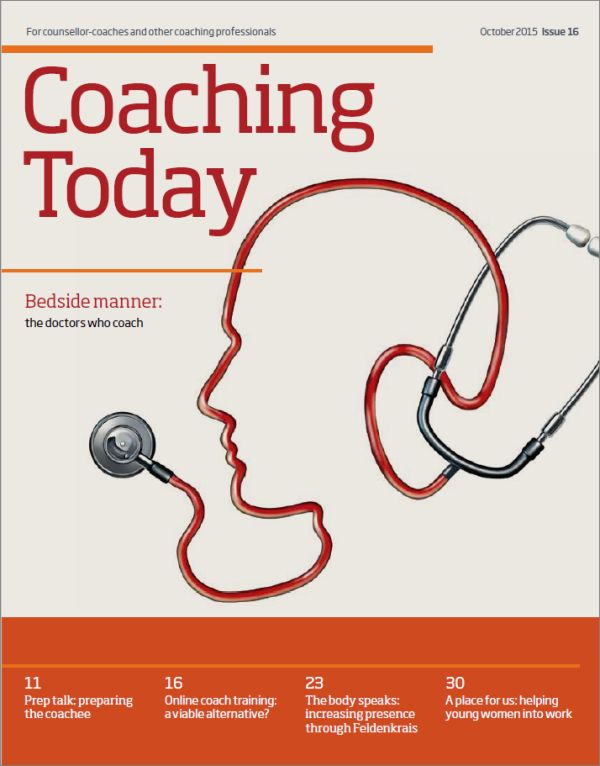In this issue
Features
‘The coach will see you now…’: developing doctors as coaches in an acute hospital setting (free article)
Dr Debra King and Nicola Forshaw
Beyond performance management: preparing the coachee for better breakthroughs
Jason Rawlings
Who are we and what do we do? A survey of BACP members who coach
Veronica Lysaght
Impact and presence: the Feldenkrais Method as an aid to coaching practice
Garet Newell and Paul Ogden
We can work it out: helping young women into work
Dr Carole Easton
Regulars
Opinion
Online training for coaching in education: an alternative to face to face?
Dr Andrea Giráldez
Why I became a coach
Self-care vs client care: learning the hard way
Hilary Martin

A pdf of this issue is available in the Coaching Today archive
Editorial
When is a coach not a coach? I found myself asking this question as I was planning this latest issue of Coaching Today. Earlier this year, I was commissioned by a community mental health recovery and wellbeing centre to provide weekly creative movement and improvisation group workshops, which drew on my skills and background as an improvisation facilitator but also on my training as a newly qualified dance movement psychotherapist. In effect, I was creating something of a hybrid group intervention that could have been described as dance therapy in all but name.
In reflecting on and writing about my experience for the Association for Dance Movement Psychotherapy (ADMP) members’ journal, I was compelled to ask: ‘When is a dance therapist not a dance therapist?’ and the articles that make up this issue of our journal have led me to ask similar questions around coaching.
So, when is a coach not a coach? What is it we are doing, and who is doing it? Who do we work with, where and in what contexts? These are timely questions, given the inclusion of coaching in the latest edition of the Ethical Framework, as reported in this issue by our Chair, Gill Fennings-Monkman. Also in this issue, Veronica Lysaght shares the results of the latest BACP members’ survey of therapists who coach or are interested in coaching, and I am sure you’ll agree that they make for interesting and enlightening reading.
Our cover feature illustrates this theme perfectly. It describes an initiative by the Wirral University Teaching Hospital to implement an internal coaching strategy by equipping consultants with the skills to coach their own colleagues and peers. In this piece, Dr Debra King, a consultant physician at the hospital, who led the project, describes the process and the impact that coaching training has had on her own personal and professional development, supported by external coaching consultant, Nicola Forshaw. As Debra and Nicola explain, the internal coaching project took three years to implement, and one of the major obstacles they found was one of initial cynicism among the staff. However, a key outcome has been that, having witnessed the benefits of coaching among the medical staff, interest has now spread to non-medical staff at the hospital, and the coaching service has been expanded as a result. As a doctor who now coaches in the hospital, Debra describes the process as ‘one of the most valuable and rewarding experiences of my career’. I hope you will enjoy reading their story as much as I did.
Health and self-care have also emerged as something of a theme in this issue. In the second article of our ‘Why I Became a Coach’ series, Hilary Martin tells the story of her professional transition from NHS counsellor to private health coach – and describes with raw honesty the personal challenges that led her to make that transition. Hilary’s piece provides some serious food for thought (pun intended) on how we look after ourselves as practitioners,and the message we are giving our clients when we neglect our bodies, our spirits and our physical and mental health.
Elsewhere, Garet Newell and Paul Ogden offer a fascinating case study of how bodily and physical awareness, combining coaching with the Feldenkrais Method, can help maximise presence and impact for our clients. Their piece also invites us, as practitioners, to consider our own physical presence when working with our clients.
Thank you for all of your feedback on the summer issue, particularly your comments on our two new series. Please keep your feedback coming – it all helps shape the journal for the future. In the meantime, as we move from autumn into winter, I wish you all good health and an abundance of self-care.
Diane Parker
Editor
editorial@bacpcoaching.co.uk
